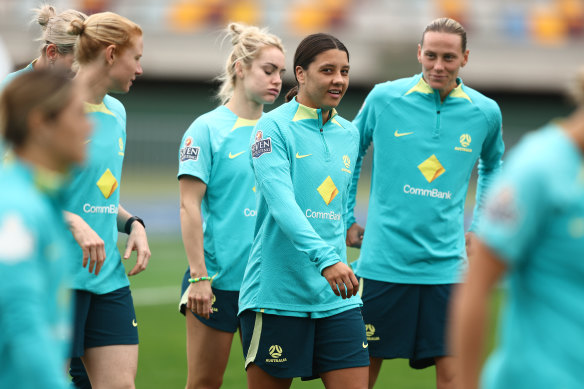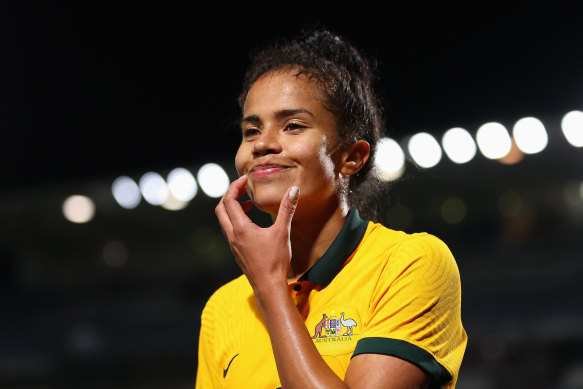‘They’re all in sync together’: How the Matildas manage their menstrual health
Save articles for later
Add articles to your saved list and come back to them any time.
Many women swear the syncing of menstrual cycles is nothing more than an old wives’ tale, a spurious urban legend reserved for the superstitious. For the Matildas, though, anecdotal evidence suggests the phenomenon is very real.
“The girls all seem to get in sync with each other in terms of when their cycle is as soon as they come into camp,” says the national team’s physician, Dr Brandi Cole. “It is absolutely crazy. One will come to me for some meds for premenstrual pain and then the next minute half the team’s coming to me. It’s a known phenomenon.”
Dr Cole could not tell you the science behind a squad of players flying in from separate clubs around the world, at different stages of their menstrual cycle, and leaving after the 10-day international window with their bodies in harmony.
“But the girls swear by it and I have definitely seen that,” she says. “If we’re monitoring them out of camp, they’ll be out of sync, and then by the time we’re in a big camp they’re all in sync together.
“One of the girls has said to me that she always gets a period earlier than what she’s expecting when she comes to international team camp, and other girls have said they get delayed by a couple of days.
“That’s the good thing about menstrual cycle monitoring – they’re starting to learn about themselves, which empowers our female athletes to get the best out of their bodies.”
The fact we are even talking about this demonstrates how far women’s football has come since the days when women wore white kits made to fit men and menstruation was a taboo topic around the dinner table, let alone in a high-performance environment.
So far has it – and women’s sport – come, that menstrual cycle monitoring is now a normalised part of training. In 2019, when the United States won the Women’s World Cup in France, they did so by pioneering menstrual cycle monitoring and intervention strategies, and then told the world about it.
“We get periods. Whatever,” Megan Rapinoe tweeted at the time. “Might as well [do] everything you can about it to maximise performance.”
Medical research into women’s bodies and sporting performance has made even further headway in the past four years, to the point that a new-age method known as “phase-based training” is implemented by well-resourced national teams and clubs.
Australia’s national team are closely monitored for symptoms which could affect their performance and overall health.Credit: Getty
The concept centres around the four main phases of the menstrual cycle – menstruation, the follicular phase, ovulation and the luteal phase – and tailors training loads to cater for the varying hormone levels in each phase.
But the Matildas are not – at this early stage, at least – strong proponents of phase-based training, which head of sport science Jack Sharkey believes is a trendy “buzzword” which sounds revolutionary in theory but “in reality, in team sport, is very, very difficult to implement”.
“As far as I’m concerned, there’s not any clubs out there who are doing it effectively for the whole team,” Sharkey says. “Every individual is different and therefore going to do different types of exercises at certain points of their cycles.
“The second issue you have is it’s actually very hard to differentiate when one phase goes into the other, like when the follicular phase goes to the luteal phase, so it’s very hard to say this is when it transitions to that phase of the cycle.”
Given the sheer complexity and relative paucity of research, both Sharkey and Dr Cole agree that a more effective approach is to monitor menstrual health in general. That means noting missed periods and ascertaining whether that is linked to a nutritional deficiency, and observing symptoms such as dysmenorrhea (menstrual pain) and signs of endometriosis.
“We definitely have a lot of that affects our team,” says Cole, who is also the assistant doctor for the Sydney Roosters NRL team and a private sports and exercise physician treating elite female athletes across a range of sports. “That’s really hard for the girls because there’ll be a couple of days [when] one of my players might be in the fetal position on the bathroom floor for four hours vomiting and in pain on the day of the game. You can imagine that that’s not the greatest prep going into a game.
Mary Fowler has helped normalise the conversation around menstruation.Credit: Getty
“Girls felt like they couldn’t complain about it or they’d be considered soft or weak. One of the biggest things that I say is if people get food poisoning they’re not called soft or weak. They’ve got symptoms that need to be treated so they can try and perform on the day.
“There is a lot more sort of research going into the menstrual cycle and there’s a lot more publicity about it. You only have to read any of the media in the last year to see that there’s a big push, which, I think, is excellent for creating awareness. But it’s almost to the point where we’ve gone so technical on it that we’re starting to look at the little one per centers and forgetting the 50 per centers.
“We try and individualise load already, so if you had to then also bring in the phase of the menstrual cycle I don’t think you’d have a team doing the same thing at training.
“So whilst it’s probably something of the future, it’s not the main priority. But menstrual health is very, very important in our athletes and it’s certainly getting more consideration now, which is just so good.”
Some players from other teams use hormonal contraceptives (the pill) to delay their periods so they can avoid symptoms around game time. On average, about 30-40 per cent of female footballers take the pill – for reasons ranging from contraception to symptom management of menstruation and endometriosis.
The effect of hormonal contraceptives on performance is an area supported by little research. In any case, the uptake among Matildas is well below that average – about 10 per cent – which may be partly why teammates find their cycles sync.
The upshot to that could be that many in the team start their periods on the day of, say, a World Cup knockout game. Even that, however, is not necessarily an accurate indication of performance.
“You may have the whole team be on their period for the game, but some girls feel better on their period,” says Dr Cole. “Some have pain two weeks prior when they ovulate and then sluggish and heavy in the few days before their period, but then when the period actually comes they feel really light free and perform better.
“So even if you have everyone’s cycle aligning, you might have some people flying and some people flat on the same day of the cycle. It’s just so individualised, and that’s further to my point that I don’t know that we can modulate everything so closely that we’re going to make the perfect athlete. We are not creating robots.
“We’re not bioengineering perfect female athletes here, we’re just trying to help each individual as much as we can to perform the best they can in the same way that we look at nutrition and sleep and recovery and training. Some girls need to train really hard all week to be prepped for a game and some need to really taper off because if they train too hard they are flat for the game.”
In short, it’s complicated. But vice-captain Steph Catley is a strong proponent of education and the recent creation of period-conscious kits. For the first time, Australia’s kit will feature period protection in the base layer under the shorts. Co-hosts New Zealand will swap their traditional white shorts for teal blue.
“Along with everything else in football that was completely male dominant, for a long time us females were in male kits and shorts that absolutely didn’t fit us,” Catley says. “The skinny legs with our big hips and just did not look right.
“It’s the same sort of thing with periods. The fact the federations and the club teams and associations are listening and saying ‘this is definitely something we can look at and we can change’ shows how far women’s football has come.
“We have a voice and we have female-specific issues and things we want to be catered for, and they’re listening and doing that. I think that’s an incredible thing.”
Most Viewed in Sport
From our partners
Source: Read Full Article


